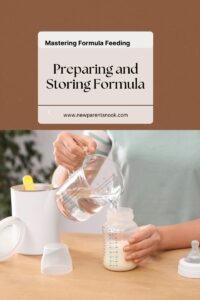Some links on our blog are affiliate links, meaning at no extra cost to you, we may earn a commission if you purchase through them. We participate in the Amazon Affiliate Program, and we recommend products we believe in. Your support helps us keep providing valuable content. Thank you!
Supplementing with Formula: A Balanced Approach to Feeding Your Baby
Deciding to supplement with formula alongside breastfeeding is a choice many families make for various reasons.
Whether it’s due to concerns about milk supply, returning to work, or simply seeking flexibility, supplementing can be a healthy way to ensure your baby gets the nutrition they need.
Here are strategies to effectively integrate formula feeding without compromising your breast milk supply, along with tips for a smooth transition.
Understanding When to Supplement
Supplementing with formula might be considered if:
- Breast milk supply is low and efforts to increase it haven’t been fully successful.
- Medical conditions make exclusive breastfeeding challenging.
- Returning to work makes it difficult to pump enough breast milk.
- Personal choice for convenience or flexibility in feeding routines.
Maintaining Breast Milk Supply
- Prioritize Breastfeeding: When possible, breastfeed first to ensure your baby is stimulating milk production. Offer formula after breastfeeding if your baby is still hungry.
- Regular Pumping: If you’re skipping a breastfeeding session to give formula, pump during that time to maintain your milk supply. Pumping tells your body to continue producing milk.
- Monitor Baby’s Growth: Keep track of your baby’s weight gain and growth to ensure they’re getting enough nutrition from both breast milk and formula.
Introducing a Bottle
- Choose the Right Time: Introduce a bottle after breastfeeding is well-established but before your baby is likely to refuse it, typically around 3-4 weeks old.
- Select an Appropriate Nipple: Use a slow-flow nipple to mimic the breastfeeding experience, making it easier for your baby to switch between breast and bottle.
- Involve Other Caregivers: Sometimes, babies are more receptive to bottles when someone other than the breastfeeding parent offers it. This can help avoid confusion.
Balancing Breastfeeding and Formula Feeding
- Create a Routine: Establishing a predictable feeding routine can help you balance breastfeeding and formula feeding. Be flexible and adjust as your baby’s needs change.
- Feed on Demand: Continue to offer the breast on demand to encourage milk production and maintain the breastfeeding relationship.
- Be Patient: It might take some time for both you and your baby to adjust to a new feeding routine. Observe your baby’s cues and respond to their needs.
Tips for a Smooth Transition
- Gradual Introduction: Slowly introduce formula to give your baby time to adjust to the taste and digestion differences.
- Stay Informed: Understanding how to properly prepare, store, and offer formula will ensure your baby receives safe and nutritious feedings.
- Seek Support: Don’t hesitate to reach out to a lactation consultant or pediatrician for advice and support as you navigate supplementing.
Supplementing with formula doesn’t mean the end of your breastfeeding journey.
Many families find a happy balance that works for their unique circumstances, allowing them to enjoy the benefits of both breastfeeding and formula feeding.
By paying attention to your baby’s needs and maintaining your milk supply, you can provide your baby with the love and nutrition they deserve in a way that supports your family’s lifestyle and goals.







